| Topic: DRAGONS UNICORNS MERMAIDS PEGASUS OTHER MYTHIC ANIMALS | |
|---|---|
   I think so to I think so to
|
|
|
|
|
|
It lead to many people from Hollywood to be Id as aliens.
   
|
|
|
|
|
|
I wonder if Jerry Springer posed as an alien
  
|
|
|
|
|
|
The show was about him so it was his last show.
|
|
|
|
|
|
I got a kick out of that show, didn't watch it all the time, actually some of it was kinda dumb
 
|
|
|
|
|
|
I watched it once, that was enough for me.
|
|
|
|
|
|
Yay!!!! lets have the women stand up and show there boobs, that way the get beads, that was also part of the show, it was quite dumb.

|
|
|
|
|
|
I watch it the one time. I think it was about a mother controlling her 32 year old sons life. She set him up with with another girl because she did not like his wife.

|
|
|
|
|
  Actually I heard that most of his shows were fake, and they were just actors. Actually I heard that most of his shows were fake, and they were just actors.
|
|
|
|
|
|
Well it was one show. I glad I did not watch any more than that one.
|
|
|
|
|

Forgive me for jumping in But I believe this one doesn't fit into the Grey category. It's a cross between a Predator and a Alien from the movie series. Both of which are completely fictional and modern day movie contrivances. Fascinating read none the less. I'll need to look through this more carefully when I have a chance. |
|
|
|
|

Forgive me for jumping in But I believe this one doesn't fit into the Grey category. It's a cross between a Predator and a Alien from the movie series. Both of which are completely fictional and modern day movie contrivances. Fascinating read none the less. I'll need to look through this more carefully when I have a chance. I know it was mention in the grey's section of aliens. Plus the skull kind of fit the the whole read. Thanks jump in at any time sir. Do indeed like new things to read. I been kind of busy running around. Been kind of reading and editing the information. So add please. Have a grand one sir. |
|
|
|
|
|
Edited by
tazzops
on
Sun 08/21/11 06:49 AM
|
|

But the pictures helps to mark the reptile as the oldest animal on the planet. This rare picture of a Boer war prisoner snapped on the remote island of St Helena, has shed light on one of the planets oldest living inhabitants Jonathan, the tortoise, is believed to be 178-years-old and was about 70 at the time the black and white picture was taken. He was photographed during the Boer War around 1900, and his life has spanned eight British monarchs from George IV to Elizabeth II, and 50 prime ministers. It was taken on the South Atlantic island of St Helena, where Jonathan still lives today, along with five other tortoises David, Speedy, Emma, Fredricka and Myrtle, in a plantation. The previous oldest tortoise was widely thought to be Harriet, a giant Galapagos Land tortoise, who died in 2005 aged 175 in Australia. Despite his old age, locals say he still has the energy to regularly mate with the three younger females. A spokesman for the island's tourist board said Jonathan is owned by the St Helena government and lives in the specially built plantation on the governor's land. He said: "Jonathan is the sole survivor of three tortoises that arrived on St Helena Island in 1882. "He was already mature when he arrived and was at least 50-years-old. "Therefore his minimum age is 178-years-old. He is the oldest inhabitant on St Helena and is claimed to be the oldest living tortoise in the world. "He lives in the grounds of Plantation House which is the governor's residence with five other tortoises who are much younger than him. "Apparently he remained nameless for the most part of his residence in St Helena until he was named by Governor Sir Spencer Davis in the 1930s. "He feeds on the grass of the main paddock. "Jonathan is still very active despite his age and adores attention, he is a real poser. "He seems to be sightless in one eye, but does not let that slow him down." It is thought Jonathan, from the species Testudinipae cytodira, was brought to St Helena from the Seychelles as a mature adult in 1882. His remarkable existance has come to light after the photograph was discovered as part of a collection of Boer War images taken by a man named L.A. Innes who had a studio in the British overseas territory's capital Jamestown. The pictures were recently sold at auction for £4,000 by Andrew Smith and Son auctioneers near Winchester, Hants. Further investigation by the auctioneers revealed the tortoise in the picture was Jonathan who was still alive. St Helena has a population of more than 4,200. Its greatest claim to fame came when Napoleon was exiled there in 1815. He was held prisoner there until his death in 1821 and is buried there. Another tortoise, Timothy, who was a ship's mascot in the Crimean War, died at his home at Powderham Castle, near Exeter, Devon, in 2004, aged 160. The castle's Rose Garden had been his home since 1935. |
|
|
|
|
|
Edited by
tazzops
on
Sun 08/21/11 07:21 AM
|
|

Sloths are medium-sized mammals that live in Central and South America belonging to the families Megalonychidae and Bradypodidae, part of the order Pilosa. Most scientists call these two families the Folivora suborder, while some call it Phyllophaga. Sloths are omnivores. They may eat insects, small lizards and carrion, but their diet consists mostly of buds, tender shoots, and leaves. Sloths have made extraordinary adaptations to an arboreal browsing lifestyle. Leaves, their main food source, provide very little energy or nutrition and do not digest easily: sloths have very large, specialized, slow-acting stomachs with multiple compartments in which symbiotic bacteria break down the tough leaves. As much as two-thirds of a well-fed sloth's body-weight consists of the contents of its stomach, and the digestive process can take as long as a month or more to complete. Even so, leaves provide little energy, and sloths deal with this by a range of economy measures: they have very low metabolic rates (less than half of that expected for a creature of their size), and maintain low body temperatures when active (30 to 34 degrees Celsius or 86 to 93 degrees Fahrenheit), and still lower temperatures when resting. Sloths mainly live in Cecropia trees. |
|
|
|
|
|
Edited by
tazzops
on
Sun 08/21/11 07:25 AM
|
|
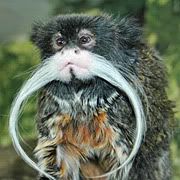

The Emperor Tamarin (Saguinus imperator) is a tamarin allegedly named for its similarity with the German emperor Wilhelm II. The name was first intended as a joke, but has become the official scientific name. This tamarin lives in the southwest Amazon Basin, in east Peru, north Bolivia and in the west Brazilian states of Acre and Amazonas. The fur of the Emperor Tamarin is predominantly grey colored, with yellowish speckles on its chest. The hands and feet are black and the tail is brown. Outstanding is its long, white mustache, which extends to both sides beyond the shoulders. The animal reaches a length of 24 to 26 cm, plus a 35 cm long tail. It weighs approximately 300 to 400 g. This primate inhabits tropical rain forests, living deep in the forest and also in open tree-covered areas. It is a diurnal animal, spending the majority of its days in the trees with quick, safe movements and broad jumps among the limbs. |
|
|
|
|
|
Edited by
tazzops
on
Sun 08/21/11 07:29 AM
|
|

The Axolotl (or ajolote) (Ambystoma mexicanum) is the best-known of the Mexican neotenic mole salamanders belonging to the Tiger Salamander complex. Larvae of this species fail to undergo metamorphosis, so the adults remain aquatic and gilled. The species originates from the lake underlying Mexico City. Axolotls are used extensively in scientific research due to their ability to regenerate most body parts, ease of breeding, and large embryos. They are commonly kept as pets in the United States, Great Britain, Australia, Japan (where they are sold under the name Wooper Rooper, and other countries. Axolotls should not be confused with waterdogs, the larval stage of the closely related Tiger Salamanders (Ambystoma tigrinum and Ambystoma mavortium), which is widespread in much of North America which also occasionally become neotenic, nor with mudpuppies (Necturus spp.), fully aquatic salamanders which are unrelated to the axolotl but which bear a superficial resemblance. |
|
|
|
|
|
Edited by
tazzops
on
Sun 08/21/11 07:33 AM
|
|
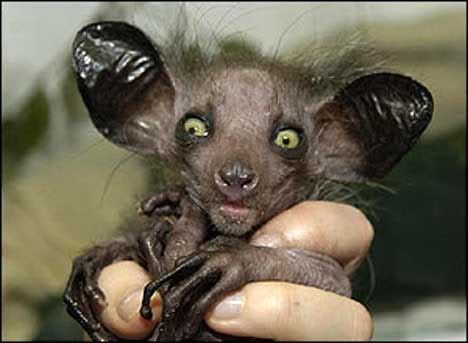
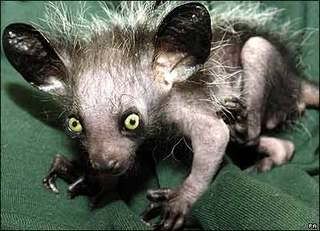
The Aye-aye (Daubentonia madagascariensis) is a strepsirrhine native to Madagascar that combines rodent-like teeth with a long, thin middle finger to fill the same ecological niche as a woodpecker. It is the world's largest nocturnal primate, and is characterized by its unique method of finding food; it taps on trees to find grubs, then gnaws holes in the wood and inserts its elongated middle finger to pull the grubs out. Daubentonia is the only genus in the family Daubentoniidae and infraorder Chiromyiformes. The Aye-aye is the only extant member of the genus (although it is currently an endangered species); a second species (Daubentonia robusta) was exterminated over the last few centuries. |
|
|
|
|
|
Edited by
tazzops
on
Sun 08/21/11 07:35 AM
|
|
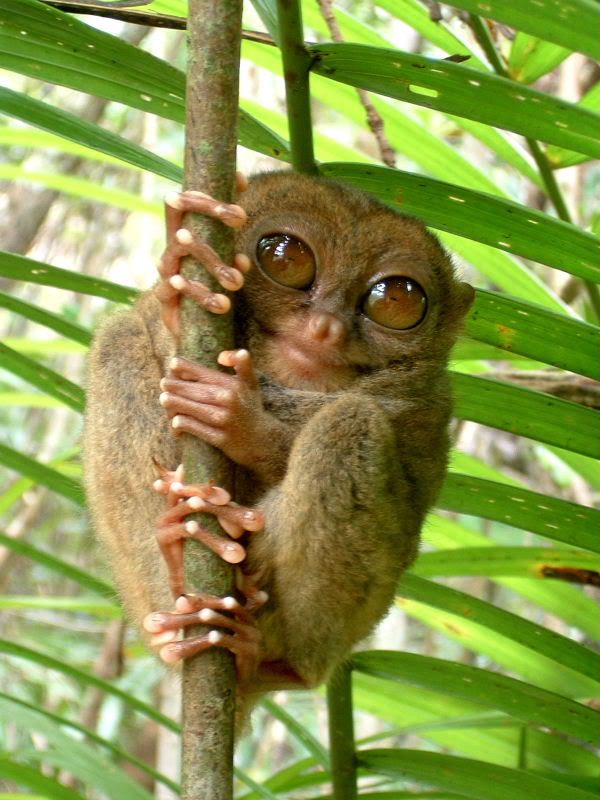
Tarsiers are prosimian primates of the genus Tarsius, a monotypic genus in the family Tarsiidae, which is itself the lone extant family within the infraorder Tarsiiformes. The phylogenetic position of extant tarsiers within the order Primates has been debated for much of the past century, and tarsiers have alternately been classified with strepsirrhine primates in the suborder Prosimii, or as the sister group to the simians (=Anthropoidea) in the infraorder Haplorrhini. Analysis of SINE insertions, a type of macromutation to the DNA, is argued to offer very persuasive evidence for the monophyly of Haplorrhini, where other lines of evidence, such as DNA sequence data, had remained ambiguous. Thus, some systematists argue that the debate is conclusively settled in favor of a monophyletic Haplorrhini. Tarsiers have enormous eyes and long feet. Their feet have extremely elongated tarsus bones, which is how they got their name. They are primarily insectivorous, and catch insects by jumping at them. They are also known to prey on birds and snakes. As they jump from tree to tree, tarsiers can catch even birds in motion.[citation needed] Gestation takes about six months, and tarsiers give birth to single offspring. All tarsier species are nocturnal in their habits, but like many nocturnal organisms some individuals may show more or less activity during the daytime. Unlike many nocturnal animals, however, tarsiers lack a light-reflecting area (tapetum lucidum) of the eye. They also have a fovea, atypical for nocturnal animals. |
|
|
|
|
|
Edited by
tazzops
on
Sun 08/21/11 07:38 AM
|
|
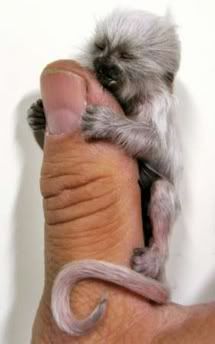
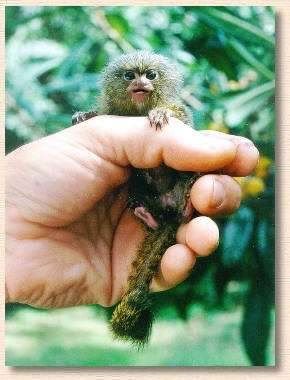
The Pygmy Marmoset (Callithrix (Cebuella) pygmaea) is a monkey native to the rainforest canopies of western Brazil, southeastern Colombia, eastern Ecuador, and eastern Peru. It is one of the smallest primates, with its body length ranging from 14-16 cm (excluding the 15-20 cm tail) and the smallest monkey. Males weigh around 140 g (5 ounces), and females only 120 g (4.2 ounces). TDespite its name, the Pygmy Marmoset is somewhat different from the typical marmosets classified in genus Callithrix. As such, it is accorded its own subgenus, which was formerly recognized as its own genus, Cebuella. TThe Pygmy Marmoset has a tawny coat, and a ringed tail that can be as long as its body. Their claws are specially adapted for climbing trees, a trait unique to the species. They are omnivorous, feeding on fruit, leaves, insects, and sometimes even small reptiles. Much of their diet, however, comes from tapping trees for sap. Up to two-thirds of their time is spent gouging tree bark to reach the gummy sap. The Pygmy Marmoset has specialized incisors for gouging holes in bark. Unfortunately, because of its small size, and its swift movements, it is very hard to observe in the wild. TIn captivity, the Pygmy Marmoset can live up to 11 years. |
|
|
|
|
|
Edited by
tazzops
on
Sun 08/21/11 07:41 AM
|
|
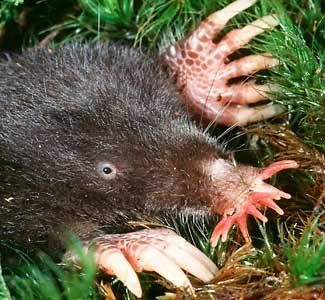
The Star-nosed Mole (Condylura cristata) is a small North American mole found in eastern Canada and the north-eastern United States. It is the only member of the tribe Condylurini and the genus Condylura. It lives in wet lowland areas and eats small invertebrates, aquatic insects, worms and molluscs. It is a good swimmer and can forage along the bottoms of streams and ponds. Like other moles, this animal digs shallow surface tunnels for foraging; often, these tunnels exit underwater. It is active day and night and remains active in winter, when it has been observed tunnelling through the snow and swimming in ice-covered streams. Little is known about the social behavior of the species, but it is suspected that it is colonial. The Star-nosed Mole is covered in thick blackish brown water-repellent fur and has large scaled feet and a long thick tail, which appears to function as a fat storage reserve for the spring breeding season. Adults are 15 to 20 cm in length, weigh about 55 g, and have 44 teeth. The mole's most distinctive feature is a circle of 22 mobile, pink, fleshy tentacles at the end of the snout. These are used to identify food by touch, such as worms, insects and crustaceans. |
|
|
|
|








